MONTEREY COUNTY HIGHLIGHTS: 2000
Text by Don Roberson. Photos on this page are copyrighted
by the photographers to whom they are attributed, and may not be
reproduced in any form (including other web sites) without the express
consent of the photographer. The abbreviation "MTY" means "Monterey County"
in the text below.
These highlights chronicle the year 2000. They were created incrementally
and reposted as new photos were available; thus the year runs "backwards"
from December to January Y2K. December's apex was a first county record
of McCown's Longspur Calcarius mccownii in a huge flock of
Horned Larks east of Gonzales. This same field held a handful of Lapland
and Chestnut-collared Longspurs in Nov-Dec but Todd Easterla discovered
MTY's first McCown's on 3 December; it was well seen by various local birders
the next day (good written details on file) but was not photographed.
 What
was photographed was this male
Common Grackle Quiscalus quiscula
(left)
in a private yard near Pt. Sur on 16 November (photo © Lis Covello;
used with permission). The photographer knew it was something different
but did know what it was; it was identified by Craig Hohenberger from a
series of prints several weeks later. Remarkably, another print in the
series shows a female Common Grackle at the same bird bath (see below
right for both Common Grackles)! This represents just the second MTY
record. Amazingly, the first county record was in an adjacent yard on 21
Apr 1998.
What
was photographed was this male
Common Grackle Quiscalus quiscula
(left)
in a private yard near Pt. Sur on 16 November (photo © Lis Covello;
used with permission). The photographer knew it was something different
but did know what it was; it was identified by Craig Hohenberger from a
series of prints several weeks later. Remarkably, another print in the
series shows a female Common Grackle at the same bird bath (see below
right for both Common Grackles)! This represents just the second MTY
record. Amazingly, the first county record was in an adjacent yard on 21
Apr 1998.
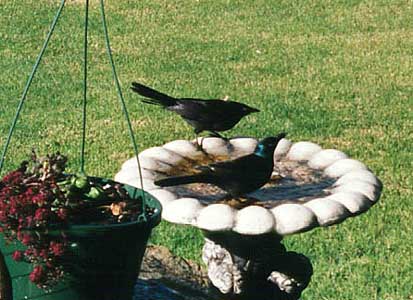
Fall migration in 2000 was fairly routine with average-to-low numbers
of eastern vagrants, and almost nothing in the way of Siberian vagrants.
Eastern warbler vagrants were noticeable down. Excluding Palm Warblers,
MTY has averaged about 70 vagrant warblers each fall over the last ten
years (Palm Warblers add another 35-45/autumn). This year's 55 vagrant
warblers was a poor showing with only Chestnut-sided (6 birds; avg 5) and
Prairie (3 birds; avg 3) at or over decadal averages. A dozen Blackpolls
were below the average of 17, and Palms were dramatically down. Only 8
Palm Warblers were reported; the average is 36 or 44, depending on whether
the incredible 122 in fall '93 is included in the statistics. While rare
warblers, tanagers, grosbeaks and Indigo Buntings were few, two Dickcissels
were unexpected treats; a Mourning Warbler was banded by BSOL; and a male
Hooded delighted birders at Pt. Pinos.
The highlight of this autumn was an exceptional four Painted Buntings
Passerina
ciris on the Big Sur coast, three of them banded
at the Big Sur Ornithology Lab. Ivan Samuels -- interning at BSOL this
fall -- photographed these three Painted Buntings in-hand: from left to
right -- 27 August, 6 September, and 20 September (© 2000 I. Samuels).
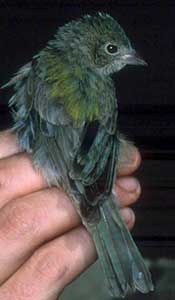
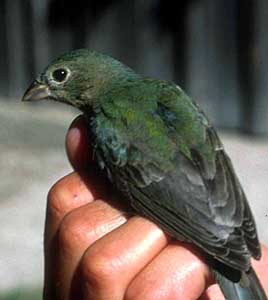
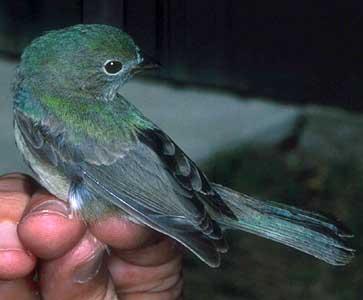
I was fortunately enough to refind the 27-Aug-banded bird in the "headlands
patch" at the Big Sur R. mouth on 2 September; a site more than a mile
distant from the banding lab. I was the first person on the trail at dawn
and this drab Painted Bunting was sitting in the middle of the path, reaching
up and eating seeds from weed stalks (in a behavioral manner that recalled
humans eating ears of corn), until flushed into the willows by the first
surfers heading to the beach. I knew it was the bird banded six days before
because of the bright shiny metal band on the right leg.
Monterey's first PABU was seen 9 Oct 1996 at Big Sur R. mouth (Jim Booker),
the second was on 19 Sep 1999 at Carmel R. mouth (Steve Rovell, Dave Werner
+) and then came the three banded at BSOL. On 14 Oct 2000 another bright
green immature was at the River Inn, Big Sur (Rick & Cheryl Fournier),
bringing the Monterey County (MTY) total to six individuals.
California specimens have been attributable to the slightly larger western
race P. c. pallidior but new research (Thompson 1991a, 1991b) suggests
that subspecific distinctions are minor and clinal and do not warrant nomenclatural
status. However, this same research shows there are biological differences
between eastern and western populations (populations that are different
than the described subspecies). Western birds migrate two months before
eastern birds to the deserts of s. Arizona and nw. Mexico and begin flight
feather molt there before continuing on to wintering locales from s. Texas
to Central America. Many of these birds are in a supplemental plumage (an
unusual extra plumage between juvenal and basic plumage) and begin a pre-basic
molt in migration (see Thompson 1991a; names of molts revised in Lowther
et al. 1999). Eastern populations complete flight-feather molt before migrating
to s. Florida and the Caribbean. [It is possible that western and eastern
populations could be considered separate species in the future.] California
vagrants, including the MTY birds, are all likely from the western population
and some are likely in supplemental plumage when they stray this far west.
In looking at these photos and comparing them to descriptions in Pyle (1997)
it looks like the first banded bird may have been in juvenal plumage (mostly
gray head with only a green wash to the back; incidentally, my field notes
for 2 Sep describe this same combination plus a paler area on the lores,
further confirming that it is the same bird as banded 27 Aug) and the next
two in supplemental plumage. Others with more banding experience may have
different opinions; I would welcome hearing them. Another interesting point
in comparing the three shots is the variation is size/shape of the bills.
 July
2000 was highlighted by yet another first county nesting record: a pair
of Black Skimmers attempted to breed at the Salinas River NWR pond
where up to 5 birds were present off and on through the month. In the first
week of July, John and Ricky Warriner determined that the nest had
3
eggs. Alas, the nest was predated (possibly by a skunk) and abandoned
on July 10. This now means that six species have been documented nesting
in Monterey County since the Breeding Bird Atlas project of 1988-1992 (Snowy
Egret, Heermann's Gull, Black Skimmer, American Redstart, Indigo Bunting,
Great-tailed Grackle).
July
2000 was highlighted by yet another first county nesting record: a pair
of Black Skimmers attempted to breed at the Salinas River NWR pond
where up to 5 birds were present off and on through the month. In the first
week of July, John and Ricky Warriner determined that the nest had
3
eggs. Alas, the nest was predated (possibly by a skunk) and abandoned
on July 10. This now means that six species have been documented nesting
in Monterey County since the Breeding Bird Atlas project of 1988-1992 (Snowy
Egret, Heermann's Gull, Black Skimmer, American Redstart, Indigo Bunting,
Great-tailed Grackle).
John Sorensen took this wonderful shot (left) of a juvenal Black
Skimmer at Del Monte Beach, Monterey, on 27 Sep 2000 (photo ©
2000 J. Sorensen). Although the Monterey County nesting pair failed, skimmers
have been successfully nesting in south San Francisco Bay over the past
decade; this young bird presumably hatched from an S. F. Bay nest and was
heading south on migration. We see small numbers of skimmers here in Monterey
County each spring and fall migration.
Another highlight in July was not avian, but rather unprecedented numbers
of Leatherback Sea-turtles inside Monterey Bay, coincident with a major
bloom of jellyfish (Leatherbacks feed almost entirely of jellyfish); I
have an introduction to the world's 8 sea-turtle HERE.
Birders now have daily access to Monterey Bay through Monterey Bay Whale
Watch's six-hour trips from Fishermans Wharf, Monterey (only $39/trip;
full
details and on-line reservations through their web site). Nearly all
trips are captained by Richard Ternullo, Monterey Bay's most experienced
bird-skipper. Although these are first and foremost cetacean trips for
the general public, the regular daily access gives birders impressive new
opportunities for pelagic birdwatching.
The interaction of birds and pelagic mammals was highlighted in July
when a dead California Sea Lion washed ashore on the Big Sur coast. The
carcass was located by our local California Condors which have released
in efforts to re-establish this endangered species here. These young condors
could be seen consistently from dirt pull-outs along Highway 1 some 7.1
miles south of "Nepenthe" restaurant, and just a half mile north of the
entrance to Julia Pfeiffer-Burns State Park. Even after the sea lion had
been completely devoured by month's end, the young orange-tagged condors
were still spending a lot of time on the beach, presumably hoping another
meal would wash ashore..... [details on California Condors in Monterey
County, including photos of birds from Sespe releases that visited here
in early summer, are on this site HERE].
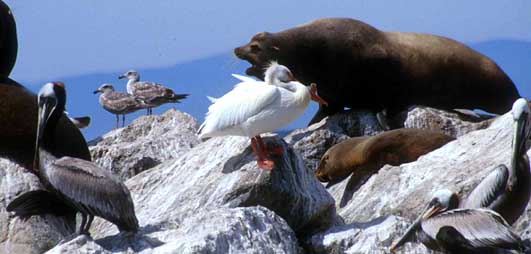 17 May 2000
17 May 2000
American White Pelican
Pelecanus erythrorhynchos
at Monterey harbor
Photo 17 May 2000 © 2000 Richard Ternullo
Only a few White Pelicans summer in Monterey County, and May records
are particularly few. Any American White Pelican on the Monterey
Peninsula is exceptional, so the presence of one 17 May on the Monterey
Harbor breakwater (aka Coast Guard Pier) is particularly noteworthy, both
for its date and its locale. Richard Ternullo took this shot of
the roost pelican among Brown Pelicans, Western Gulls, and aggressive California
Sea Lions.
 Note
that this bird is banded on its right foot with a metal USFW band, but
that we can't read the number. Presumably this bird accounts for one-day
records at Carmel R. lagoon 14 May (Alana Murphy) and at the Salinas R.
mouth 28 May (Rita Carratello, Don Roberson; the worn bird there had the
same knob on the bill).
Note
that this bird is banded on its right foot with a metal USFW band, but
that we can't read the number. Presumably this bird accounts for one-day
records at Carmel R. lagoon 14 May (Alana Murphy) and at the Salinas R.
mouth 28 May (Rita Carratello, Don Roberson; the worn bird there had the
same knob on the bill).
In late July, a huge influx of Brown Pelicans brought with them a nearly
all-white leucistic or albino Brown Pelican (right) with pink bill.
The remiges were slightly toffee-colored (look white at distance) and there
were a few small washes of light buff on the nape, but otherwise it was
an all-white pelican the exact size and shape of adjacent Browns. This
is the first reported record of such an albino or leucistic pelican in
Monterey.
This very unusual pelican was first discovered by Yohn Gideon from his
Elkhorn
Slough Safari boat; he took this impressive photo on Elkhorn Slough
26 July 2000 [photo © 2000 Yohn Gideon]. The bird was with
hundreds of Brown Pelicans and was seen off and on in the Slough over the
next month. On 27 July, several of us (Jim Booker, BSOL interns, and me)
refound this bird at the Salinas R. mouth roosting with 700 Brown Pelicans
and 37 American White Pelicans. Quite a sight...
March-July 2000
Heermann's Gulls Larus heermanni and
Great-tailed Grackle Quiscalus mexicanus
nest again at Roberts Lake, Seaside
Photo 24 May 2000 © 2000 Don Roberson
During March-July, the now resident Great-tailed Grackles continued
to frequent Roberts Lake, Seaside, where they nested last year, and three
pairs of Heermann's Gulls also began breeding behavior on the islets
where 8 youngsters fledged from 3 nests last year. See the 1999
highlights for more details on those events which appear to be repeating
this year.
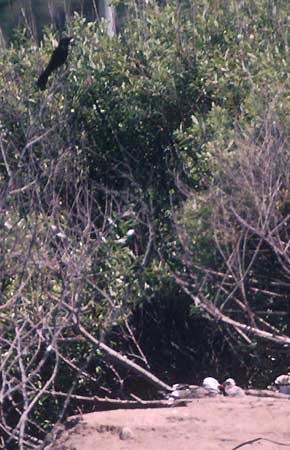 The breeding behavior that began in March led to Heermann's Gulls nesting
on the islet in Roberts Lake. Three pairs again appeared to be nesting,
and on 27 May the first chicks were seen in the front nest. By 28 May three
chicks had hatched. In this photo (left, photo taken 28 May) an adult
and just hatched Heermann's Gull chick can be seen below the bush on
which a male Great-tailed Grackle is displaying! This is the exact
spot both the gull and the grackle nested last year, providing at that
time the first nesting records of the county. By late June, grackles fledglings
were out of the nest, and by 4th of July a juv. Heermann's fledged. By
14 July, five young Heermann's were flying & swimming about Roberts
Lake.
The breeding behavior that began in March led to Heermann's Gulls nesting
on the islet in Roberts Lake. Three pairs again appeared to be nesting,
and on 27 May the first chicks were seen in the front nest. By 28 May three
chicks had hatched. In this photo (left, photo taken 28 May) an adult
and just hatched Heermann's Gull chick can be seen below the bush on
which a male Great-tailed Grackle is displaying! This is the exact
spot both the gull and the grackle nested last year, providing at that
time the first nesting records of the county. By late June, grackles fledglings
were out of the nest, and by 4th of July a juv. Heermann's fledged. By
14 July, five young Heermann's were flying & swimming about Roberts
Lake.
White-eyed Vireo Vireo griseus at Big Sur R. mouth 20
May-17 June 2000
On 20 May, Nancy McMahon was birding Andrew Molera State Park alone
and heard a loud song in the headlands patch that she did not know. Efforts
to see the bird in the dense willows with poison oak understory were unsuccessful,
and she left not knowing what she'd heard. On 24 May, Jim Booker and BSOL
interns Eddie Price, Stacey Scott, and Jason Scott (not knowing about Nancy's
bird) independently discovered a singing White-eyed Vireo at this
exact spot. That vireo was still present into early June (as I write this).
The White-eyed Vireo was just the second MTY record; the first was banded
by Big Sur Ornithology Lab back on 4 June 1994. The photo (below) is of
the banded White-eyed Vireo in 1994 (© 2000 Craig Hohenberger,
Ventana Wilderness Society's BSOL).
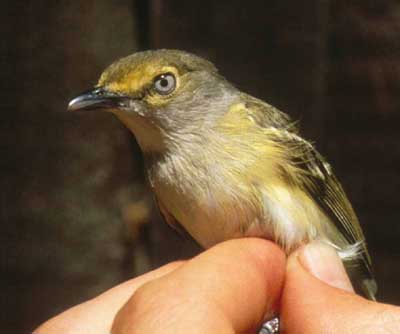
This year's White-eyed Vireo could be very difficult to see,
but when seen is a very active, perky, and colorful bird, showing the same
extent of contrasting spectacles against gray head, and bright yellow flanks,
as did the 1994 bird. The singing male remained on its territory until
at least 17 June. However, on 12 June, the Big Sur Ornithology Lab captured
another White-eyed Vireo! That latter bird showed no signs of a cloacal
protuberance (surely the singing male would have showed one) and was believed
to be a different bird. This hypothesis was confirmed on 17 June when the
singing bird was studied at close range and was unbanded.
Another trend that continues this spring is the nesting of Common Merganser
right along the coast. This is a recent phenomena -- no breeding mergansers
were found on the entire Big Sur coast during the Breeding Bird Atlas (1988-1992)
nor are there any historic breeding record here. In 1994, the first brood
of young mergansers was found in late May on the Big Sur River at Pfieffer-Big
Sur State Park. Nesting has been confirmed almost every year since, including
this May. The female Common Merganser (below; © 2000 Don Roberson)
is rushing upstream with her brood of six precocial young (half
are seen in this back-lit shot) just a few hundred yards upstream from
the Big Sur R. mouth itself.

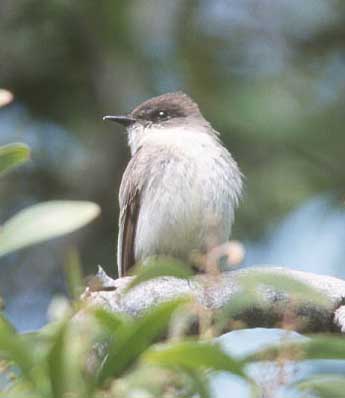
22-23 Mar 2000
Eastern Phoebe Sayornis phoebe at Carmel R. mouth
Photo Mar 2000 © 2000 Bill Hill
This flycatcher frequented the north side of the Carmel River around
the Carmel River Inn (just west of the Hwy 1 bridge) where it was discovered
by Bill Hill who also took this fine photo. It appears to be the
22nd county record since the first one was collected by Allan C. Brooks
in Pacific Grove on 7 Mar 1913.
We now seem to get one every other year, and sometimes an individual
will return for consecutive winters (one returned for 4 winters in a row
in the early 1980s). This particularly individual did not winter locally,
since the area in which it was located was regularly checked. Thus it seems
to be a migrant, staying just a short time before heading (presumably)
farther north. There are a smattering of other similar records for the
Monterey Bay area.
30 Jan-20 Feb 2000
Harris's Sparrow Zonotrichia querula near Elkhorn Slough
Photo Feb 2000 © 2000 John Sorensen
This handsome Zonotrichia is a very rare winter visitor to Monterey
County. Rick Fournier discovered this individual in a residential neighborhood
east of Elkhorn Slough (off Elkhorn Road) and it remained present (although
sometimes elusive) for nearly a month. These two great photos (below) were
taken by John Sorensen.
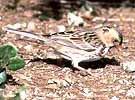 Some
local residents in the area expressed concern about the number of birders
coming to look for this individual in this small, private neighborhood,
and apparently some listers bothered locals by asking permission to enter
private property. This may yet be another case where placement of information
on Rare Birds Alert/Bird Box tapes was unwise; there appear to be a number
of instances in recent years when the pressure of listers has become too
great for the capacity of the situation. We all need to self-regulate our
impacts more carefully.
Some
local residents in the area expressed concern about the number of birders
coming to look for this individual in this small, private neighborhood,
and apparently some listers bothered locals by asking permission to enter
private property. This may yet be another case where placement of information
on Rare Birds Alert/Bird Box tapes was unwise; there appear to be a number
of instances in recent years when the pressure of listers has become too
great for the capacity of the situation. We all need to self-regulate our
impacts more carefully.
The following text is a draft from Monterey Birds, 2d ed., now
underway [publication hoped for within the year]. It describes the status
of this species within the county during the 20th century: "Fourteen records,
all amongst flocks of other wintering Zonotrichia and all but two
at feeders. An adult in Salinas returned for six consecutive winters after
it first appeared 25 Mar 1972. It was last present in 1977-78, and during
its final winter it was joined by two additional first year birds which
then returned for the following winter until last seen 1 May 1979 (all
documented by Bruce Gerow). These three individuals account for the MTY
date span of 26 Oct-1 May. In most years the adult would begin singing
in late March before departing in April. Additional records have come from
Greenfield, Corral de Tierra, Hastings NHR (one banded 18 Nov 1944), Carmel
Valley, Carmel (two near the marsh; the most recent 30 Jan-11 Feb &
15 Apr 1990), Pebble Beach, Monterey, and Pacific Grove (3 different feeders).
All these additional records fall between 18 Nov-26 Apr; about half of
the birds first appeared in December."
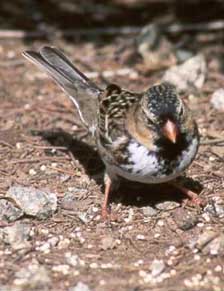 There were various claims on Rare Bird tapes about the age of this individual.
Relying primarily on Pyle (1997) I believe this bird is in its first winter
because (a) the crown is brown, heavily scalloped with black, rather than
primarily black; (b) the lores and front of supercilium are buffy brownish,
not most black; (c) the chin (not particularly visible in these shots)
looked white to me in the field; and (d) there appears to be a contrast
between the outer primary coverts (which are more worn in HY/SY birds)
and the fresher greater secondary coverts (this point ambiguous, but suggestive
in the photos). Comparative wear of the outer rectrices may also be useful,
but I cannot determine this point for the photos, and did not study it
in the field.
There were various claims on Rare Bird tapes about the age of this individual.
Relying primarily on Pyle (1997) I believe this bird is in its first winter
because (a) the crown is brown, heavily scalloped with black, rather than
primarily black; (b) the lores and front of supercilium are buffy brownish,
not most black; (c) the chin (not particularly visible in these shots)
looked white to me in the field; and (d) there appears to be a contrast
between the outer primary coverts (which are more worn in HY/SY birds)
and the fresher greater secondary coverts (this point ambiguous, but suggestive
in the photos). Comparative wear of the outer rectrices may also be useful,
but I cannot determine this point for the photos, and did not study it
in the field.
Literature cited:
Lowther, P. E., S. M. Lanyon, and C. W. Thompson. 1999. Painted
Bunting (Passerina ciris) in The Birds of North America,
No. 398 (A. Poole & F. Gill, eds. The Birds of North America, Inc.,
Philadelphia, PA.
Pyle, P. 1997. Identification Guide to North American Birds, Part 1.
Slate Creek Press, Bolinas, CA.
Thompson, C. W. 1991a. The sequence of molts and plumages in Painted
Bunting and implications for theories of delayed plumage maturation. Condor
93: 209-235.
Thompson, C. W. 1991b. Is the Painted Bunting actually two species?
Problems determining species limits between allopatric populations. Condor
93: 987-1000.
TOP
BACK TO MONTEREY
COUNTY PAGE
GO TO HIGHLIGHTS
FROM 1999
GO TO HIGHLIGHTS
FROM 1998
GO TO HOME PAGE
GO TO
IDENTIFICATION PAGE
GO TO BIRDING THE
WORLD PAGE
GO TO BIRD FAMILIES
OF THE WORLD
Page updated 31 Dec 2000
 What
was photographed was this male
Common Grackle Quiscalus quiscula
(left)
in a private yard near Pt. Sur on 16 November (photo © Lis Covello;
used with permission). The photographer knew it was something different
but did know what it was; it was identified by Craig Hohenberger from a
series of prints several weeks later. Remarkably, another print in the
series shows a female Common Grackle at the same bird bath (see below
right for both Common Grackles)! This represents just the second MTY
record. Amazingly, the first county record was in an adjacent yard on 21
Apr 1998.
What
was photographed was this male
Common Grackle Quiscalus quiscula
(left)
in a private yard near Pt. Sur on 16 November (photo © Lis Covello;
used with permission). The photographer knew it was something different
but did know what it was; it was identified by Craig Hohenberger from a
series of prints several weeks later. Remarkably, another print in the
series shows a female Common Grackle at the same bird bath (see below
right for both Common Grackles)! This represents just the second MTY
record. Amazingly, the first county record was in an adjacent yard on 21
Apr 1998.




 July
2000 was highlighted by yet another first county nesting record: a pair
of Black Skimmers attempted to breed at the Salinas River NWR pond
where up to 5 birds were present off and on through the month. In the first
week of July, John and Ricky Warriner determined that the nest had
3
eggs. Alas, the nest was predated (possibly by a skunk) and abandoned
on July 10. This now means that six species have been documented nesting
in Monterey County since the Breeding Bird Atlas project of 1988-1992 (Snowy
Egret, Heermann's Gull, Black Skimmer, American Redstart, Indigo Bunting,
Great-tailed Grackle).
July
2000 was highlighted by yet another first county nesting record: a pair
of Black Skimmers attempted to breed at the Salinas River NWR pond
where up to 5 birds were present off and on through the month. In the first
week of July, John and Ricky Warriner determined that the nest had
3
eggs. Alas, the nest was predated (possibly by a skunk) and abandoned
on July 10. This now means that six species have been documented nesting
in Monterey County since the Breeding Bird Atlas project of 1988-1992 (Snowy
Egret, Heermann's Gull, Black Skimmer, American Redstart, Indigo Bunting,
Great-tailed Grackle).
 17 May 2000
17 May 2000
 Note
that this bird is banded on its right foot with a metal USFW band, but
that we can't read the number. Presumably this bird accounts for one-day
records at Carmel R. lagoon 14 May (Alana Murphy) and at the Salinas R.
mouth 28 May (Rita Carratello, Don Roberson; the worn bird there had the
same knob on the bill).
Note
that this bird is banded on its right foot with a metal USFW band, but
that we can't read the number. Presumably this bird accounts for one-day
records at Carmel R. lagoon 14 May (Alana Murphy) and at the Salinas R.
mouth 28 May (Rita Carratello, Don Roberson; the worn bird there had the
same knob on the bill).
 The breeding behavior that began in March led to Heermann's Gulls nesting
on the islet in Roberts Lake. Three pairs again appeared to be nesting,
and on 27 May the first chicks were seen in the front nest. By 28 May three
chicks had hatched. In this photo (left, photo taken 28 May) an adult
and just hatched Heermann's Gull chick can be seen below the bush on
which a male Great-tailed Grackle is displaying! This is the exact
spot both the gull and the grackle nested last year, providing at that
time the first nesting records of the county. By late June, grackles fledglings
were out of the nest, and by 4th of July a juv. Heermann's fledged. By
14 July, five young Heermann's were flying & swimming about Roberts
Lake.
The breeding behavior that began in March led to Heermann's Gulls nesting
on the islet in Roberts Lake. Three pairs again appeared to be nesting,
and on 27 May the first chicks were seen in the front nest. By 28 May three
chicks had hatched. In this photo (left, photo taken 28 May) an adult
and just hatched Heermann's Gull chick can be seen below the bush on
which a male Great-tailed Grackle is displaying! This is the exact
spot both the gull and the grackle nested last year, providing at that
time the first nesting records of the county. By late June, grackles fledglings
were out of the nest, and by 4th of July a juv. Heermann's fledged. By
14 July, five young Heermann's were flying & swimming about Roberts
Lake.


 Some
local residents in the area expressed concern about the number of birders
coming to look for this individual in this small, private neighborhood,
and apparently some listers bothered locals by asking permission to enter
private property. This may yet be another case where placement of information
on Rare Birds Alert/Bird Box tapes was unwise; there appear to be a number
of instances in recent years when the pressure of listers has become too
great for the capacity of the situation. We all need to self-regulate our
impacts more carefully.
Some
local residents in the area expressed concern about the number of birders
coming to look for this individual in this small, private neighborhood,
and apparently some listers bothered locals by asking permission to enter
private property. This may yet be another case where placement of information
on Rare Birds Alert/Bird Box tapes was unwise; there appear to be a number
of instances in recent years when the pressure of listers has become too
great for the capacity of the situation. We all need to self-regulate our
impacts more carefully.
 There were various claims on Rare Bird tapes about the age of this individual.
Relying primarily on Pyle (1997) I believe this bird is in its first winter
because (a) the crown is brown, heavily scalloped with black, rather than
primarily black; (b) the lores and front of supercilium are buffy brownish,
not most black; (c) the chin (not particularly visible in these shots)
looked white to me in the field; and (d) there appears to be a contrast
between the outer primary coverts (which are more worn in HY/SY birds)
and the fresher greater secondary coverts (this point ambiguous, but suggestive
in the photos). Comparative wear of the outer rectrices may also be useful,
but I cannot determine this point for the photos, and did not study it
in the field.
There were various claims on Rare Bird tapes about the age of this individual.
Relying primarily on Pyle (1997) I believe this bird is in its first winter
because (a) the crown is brown, heavily scalloped with black, rather than
primarily black; (b) the lores and front of supercilium are buffy brownish,
not most black; (c) the chin (not particularly visible in these shots)
looked white to me in the field; and (d) there appears to be a contrast
between the outer primary coverts (which are more worn in HY/SY birds)
and the fresher greater secondary coverts (this point ambiguous, but suggestive
in the photos). Comparative wear of the outer rectrices may also be useful,
but I cannot determine this point for the photos, and did not study it
in the field.